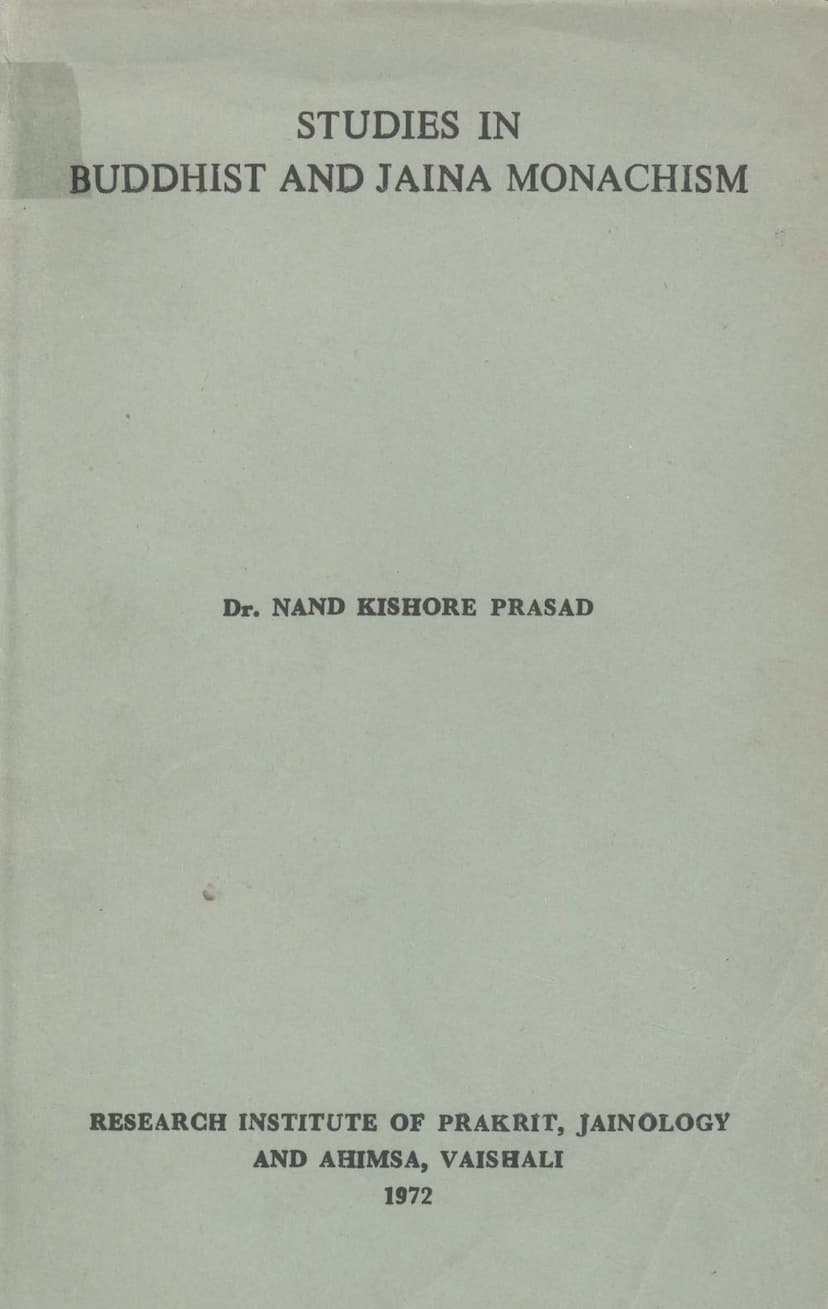Studies In Buddhist And Jaina Monachism
Added to library: September 2, 2025

Summary
"Studies in Buddhist and Jaina Monachism" by Dr. Nand Kishor Prasad, published in 1972 by the Research Institute of Prakrit, Jainology & Ahimsa, Vaishali, offers a comprehensive comparative analysis of the monastic disciplines of Buddhism and Jainism. The book, a thesis approved for a Ph.D. degree, aims to explore the origins, development, and salient features of both ascetic orders, with a particular focus on potential Jaina influence on the evolution of Buddhist monachism.
The study is structured into five chapters, delving into various aspects of monastic life:
Chapter 1: The Jaina Ācāra and the Buddhist Vinaya This chapter introduces the core concepts of Vinaya (Buddhist discipline) and Ācāra (Jaina conduct), examining their meanings and sources. It then provides an exhaustive overview of the salient features of Jaina monastic discipline, including:
- The Jaina Order and its Rules: Formation of the order, admission processes, causes of renunciation, the status of novices, attire, daily duties, and the hierarchy of officers. It highlights the fundamental Jaina principles of inoffensiveness (ahiṁsā), self-restraint (saṁyama), and penance (tapa).
- The Buddhist Vinaya: Discusses the formation of the Buddhist order, its requisites (nissayas), monastic observances (uposatha, vassāvāsa, pavāraṇā), and monastic administration.
- Background of the Buddhist Vinaya: Explores pre-Buddhist beliefs and practices, the Buddha's perspective, and concessions allowed to ascetics, particularly noting the influence of ascetic practices like dhutangas and the concept of Niggantha cāturmāsa-saṁvara.
Chapter 2: The Order: Formation and Development This chapter elaborates on the processes of initiation and the essential requisites for monks in both traditions:
- Pabbajjā and Upasampadā: Details the connotations of these terms for both religions, the admission processes, duties and obligations, causes of renunciation, disqualifications for admission, and the authorities competent to conduct these ceremonies. It notes the Buddha's initial reluctance to admit women and the imposition of stricter rules on nuns, drawing parallels with Jaina practices.
- Nissayas (Requisites): Examines the fundamental needs of monks – food (pindiyalopabhojana), clothing (paṁsukūlacīvara), shelter (rukkhamūlasenāsana), and medicine (pūtimuttabhesajja). It compares the Jaina emphasis on minimal needs and austerity with the Buddhist development of these requisites, including rules on ownership, succession, distribution, and exchange.
Chapter 3: Monastic Ceremonies This chapter focuses on the significant ceremonies observed by both orders:
- Uposatha: Discusses the Brahmanical, Buddhist, and Jaina versions of this fortnightly or periodic observance, comparing its evolution from a social gathering to a monastic ritual and its connection to confession of faults.
- Vassāvāsa (Rain-Retreat): Explores the universality of this custom among Indian mendicant orders, the causes for its institution (primarily non-injury), the periods and durations, entry procedures, indispensability, occasions for interruption, conditions for permanent transfer of residence, places suitable for retreat, and the sangha-kammas performed during this period. It highlights the Jaina emphasis on non-violence influencing their retreat practices.
- Pavarana: Explains this ceremony marking the end of the rain-retreat, its connection to confession, and its Jaina counterpart, khamāvaņā (forgiveness).
Chapter 4: Monastic Administration This chapter delves into the organizational structures of both monastic orders:
- Custodians of Monastic Discipline: Examines the church units (Sangha, Gana, Kula, Sambhoga, Gaccha, Sakhā, Mandali) and the hierarchy of officers (Acariya, Upajjhāya, Gaṇadhara, Gani, Gaṇavaccheiya, etc.) in both Buddhism and Jainism. It compares the democratic structure of the Buddhist Sangha with the more autocratic Jaina system.
- The Laws of Polity: Discusses the administration of justice, including settlement of disputes (adhikaraņa) in Buddhism and the concept of 'Vavahara' and 'Prayaścitta' (expiations) in Jainism. It compares the offenses and punishments prescribed by both traditions, noting the Buddhist emphasis on mental purification versus the Jaina focus on both mental and physical aspects.
- The Buddhist Prātimokşa & The Jaina Prāyaścitta: Provides a detailed comparative study of the codes of transgressions and expiations in both religions, analyzing their classifications, punishments, and underlying principles. It identifies areas of significant overlap and divergence, particularly the Jaina inclusion of corporal punishments and the meticulousness in their rules.
Chapter 5: Conclusion This chapter summarizes the key findings, emphasizing the mutual influence between Buddhism and Jainism, and their shared borrowing from Brahmanical traditions. It highlights Buddhism's republican organizational structure and its pragmatic approach to monastic rules, often influenced by public opinion and a desire for popularization. In contrast, Jainism is portrayed as having a more rigid, autocratic system, with a strong emphasis on austerity and non-injury that influenced its administrative and disciplinary codes. The author also reflects on factors contributing to Buddhism's wider geographical spread compared to Jainism's confinement to specific regions, attributing it partly to the practical difficulties of Jaina practices like nudity in diverse climates.
Overall, "Studies in Buddhist and Jaina Monachism" is a scholarly work that meticulously compares and contrasts the monastic frameworks of these two ancient Indian religions, offering valuable insights into their historical development, philosophical underpinnings, and practical regulations.